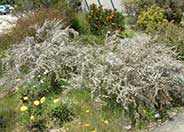
Common name:Geraldton Wax Flower
Botanical name:Chamelaucium uncinatum
This Wax Flower is a wispy, open evergreen shrub that grows to 4', bearing soft, needle-like foliage and open terminal sprays of Leptospermum-like flowers with a heavy, waxy texture. It is best known for its use as a long-lasting cut flower. This plant grows best with good drainage and little summer watering. It should be sheared after flowering in order to thicken the plant and promote flowering wood. If fertilized in fall and winter, the plant will not bloom.
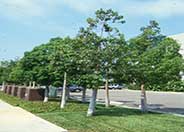
Common name:Pink Flame Tree
Botanical name:Brachychiton discolor
This tall tree will grow 40'-75' high and will do best in full sun and well-drained soil. The rose-pink, salmon blooms it produces will open after the tree loses its leaves in late spring. The flowers and large pods are covered with a dense fuzzy coating.
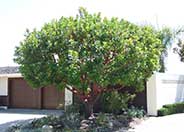
Common name:Marina Strawberry Madrone
Botanical name:Arbutus 'Marina'
Marina Strawberry Tree (Arbutus marina) is a small-to-medium evergreen tree that is one of the most popular specimen trees for Southern California gardens. It matures at 40’ tall and 30’ wide and is easily kept in the 15’ range with regular pruning. It has a deep red bark and deep green foliage that resembles a Manzanita. This tree is appropriate in almost any garden setting with almost any soil or moisture level. When it is young, it grows quickly, so it benefits greatly from some selective pruning. The natural growth habit is more shrub-like, especially in the multi-trunk form, so removing some of the lower new branches and exposing the trunk will improve the look and shape. Once the tree canopy is out of reach, a licensed arborist should maintain the tree to keep its natural shape. This tree should be planted at least three feet away from any hardscape areas, eight feet from structures such as houses and buildings, and not near any powerlines. Shrubs and perennials should be planted about two feet away from this tree. It should be irrigated for about 45 minutes once a week when using most in-line drip irrigation systems.
This tree is a hybrid of the Arbutus unedo. They share several traits, but the Arbutus ‘Marina’ grows faster and can reach a larger size at maturity. It also has a more reddish tone to its bark color.
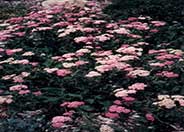
Common name:Rosea Yarrow
Botanical name:Achillea millefolium rosea
This Achillea features spreading mats of fern-like rosettes, along with deeply divided leaves of a green or gray green color. In this form, the flowers are usually a pale pink tone. Yarrow propagate easily from rooted cuttings or division, which should be performed in the early spring or fall. Following bloom, one should dead head the plant and divide the clumps when it appears crowded.
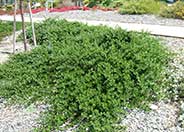
Common name:Yankee Point California Lilac
Botanical name:Ceanothus griseus hor. 'Yankee Point'
Yankee Point is a fast growing shrub that stays near 3' in height with a spread of 6'. It has large, bright green leaves and light blue flowers. It is great for banks and mass plantings. It does well on the coast and in hot inland areas. It attracts hummingbirds, butterflies and beneficial insects.
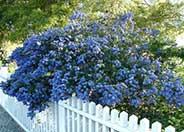
Common name:Concha California Lilac
Botanical name:Ceanothus 'Concha'
Concha is a lilac that grows 4'-8' in height and 12' wide. It has small narrow leaves with intense dark blue flower clusters in spring. It is tolerant of coastal and inland conditions.
Maintenance Tips
Ceanothus ‘Concha’ is a dramatic, evergreen native shrub that sends out dark blue flowers for about 4-6 weeks in the late spring. This is one of the hybrids of the native California Lilac and can reach 4-8' tall and up to 12' wide. It is a large, dense shrub that is drought tolerant once established and can take most soil conditions. To keep the maintenance as low as possible, give this plant the room it needs to reach its full mature size. The amount of space this plant requires is often underestimated, leading to poor pruning habits, like shearing, to control the size. If it is planted in a tight space, it is best to use the thinning method of pruning, cutting off the longest branches to the interior of the plant to allow sunlight in and to allow it to keep a natural shape. Over-watering during the hottest months of the year can lead to both pest and fungal issues. Water infrequently and deeply throughout the year and keep the soil around the base of the plant fairly dry to help discourage pest and disease problems.Designer: Stephanie Blanc
Photographer: GardenSoft